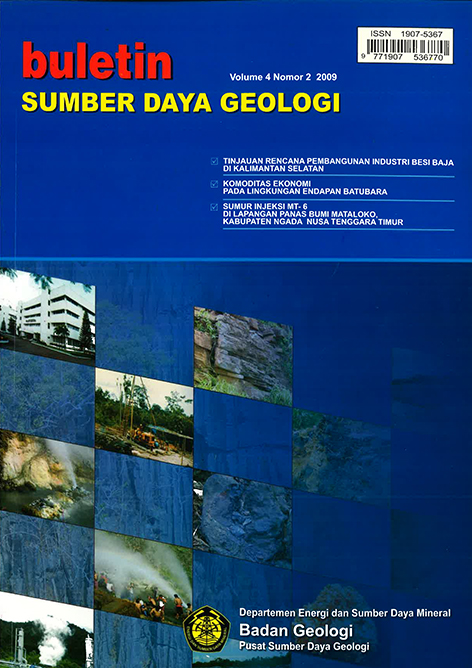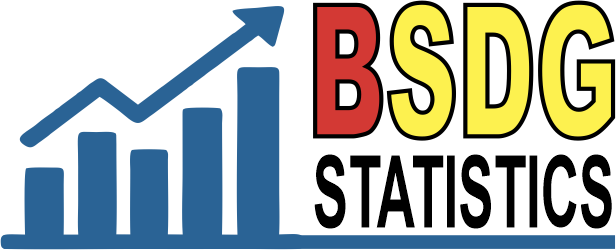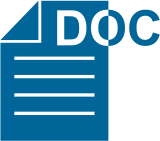SUMUR INJEKSI MT- 6 DI LAPANGAN PANAS BUMI MATALOKO, KABUPATEN NGADA – NUSA TENGGARA TIMUR
Abstract
Litologi sumur MT-6 disusun oleh Breksi Tufa Terubah dan Andesit Terubah. Mineral ubahan didominasi oleh oksida besi dan mineral lempung (kaolinit, smektit dan montmorilonit), dengan/tanpa, pirit, karbonat/kalsit, kuarsa sekunder, dan anhidrit dengan Intensitas ubahan bervariasi dari sedang sampai sangat kuat, termasuk dalam tipe ubahan argilik dikelompokkan menjadi lapisan over burden dan lapisan penudung. Mulai kedalaman 42.45 m terjadi hilang sirkulasi total (TLC), atasi TLC dengan berbagai macam material loss (LCM) dan beberapa kali semen sumbat, tidak berhasill. Operasi pemboran dilanjutkan dengan bor buta sampai kedalaman 123.76 m. Zona loss diperkirakan berupa rongga besar terutama pada interval kedalaman 43 s/d 48 m, ditunjukkan dengan terjadinya “drilling break”, rekahan diperkirakan menerus tidak teratur
sampai dasar, interpretasi ini diperkuat oleh terjadinya TLC walaupun telah dimasukan puluhan meter kubik LCM dan lebih dari 2000 M3 air serta lumpur.
Temperatur sumur injeksi MT-6 di kedalaman 123 m terukur = 63.2 C, menunjukkan adanya gradien panas di kedalaman tersebut, tetapi tidak akan menimbulkan semburan karena masih jauh ke temperatur “boilling point”.
Sumur MT-6 cocok digunakan sebagai sumur injeksi di lapangan panas bumi Mataloko, karena tidak berpengaruh terhadap sumur-sumur terdahulu (MT-2, MT-3, MT-4, dan MT-5), tidak ada aliran balik (TLC), serta tidak mengkontaminasi mata air di sekitar lokasi sampai jarak 4 km dengan beda ketinggian lebih dari 300 m.
Downloads
References
Akasako, H., Matsuda, K., Tagamori, K.,Koseki, T., Takahashi, H. and Dwipa, S. (2002). Conceptual models for geothermal system in the Wolo Bono, Nage and Mataloko field, in Bajawa area, Central Flores, Indonesia. Special Publication: Indonesia – Japan Geothermal Exploration Project in Flores Island, p. 395 –410.
Badan Standardisasi Nasional, 2001.Prosedur Uji Alir Fluida Sumur Panas
Bumi, SGSM 32 – 2002.
Bain, R.W. (1964) Steam Tables. Physical Properties of Water and Steam (0 – 800 °C and 0-100 bars). Published by Her Majesty’s Stationery Office, p. 147.
Directorate of Mineral Resources and Inventory (2001), Flow test report of the MT-2 well. The Mataloko Geothermal Field, Ngada – Flores Island, East Nusatenggara. Published by DMRI, p.130.
Menzeis A.J, Roux at all, 1979.,Temperature Trancient Analyze.
Menzeis A.J, Roux at all, 1979, Horner Plot.
Muraoka, H., Nasution, A., Urai, M., Takahashi, M and Takashima, I. (1999). A geothermal regime constrained by dike – shaped magma in Bajawa, Flores, Indonesia. In Abtract of 1999 Annual Meeting of Geothermal Research Society of Japan.
Nanlohy, F dkk, 1997 : Geologi Daerah Panas Bumi Mataloko, Kabupaten Ngada,Flores-NTT. Laporan Dit. Vulk. Tdk dipubl.
Nanlohy, F dkk, 1998 : Laporan Geologi dan Pemetaan Batuan Ubahan Daerah Panas Bumi Mataloko, Kabupaten Ngada, Flores Tengah-NTT. Laporan Dit. Vulk. Tdk. Dipubl.
Nanlohy, F., Sitorus, K., Kasbani, Dwipa, S and Simanjuntak, J. (2002). Sub surface geology of the Mataloko geothermal field, deduced from MTL –01 and MTL-2 wells, Central Flores, East Nusatenggara, Indonesia. Special Publication : Indonesia – Japan Geothermal Exploration Project in
Flores Island, p. 335 – 345.
Nanlohy, F dkk, 2004 Laporan Pemboran Sumur Deliniasi MT-4, Lapangan Panas Bumi Mataloko, Kabupaten Ngada NTT.
Sitorus, K., Fredy, N (2000) SubsurfaceGeology of the Mataloko Shallow Well (MTL –01), the Mataloko Geothermal Field ,Ngada – NTT, Flores – Indonesia. IAVCEI( 18 –22 July 2000), Bali – Indonesia.
Sitorus,K., Fredy, N., and Simanjuntak, J (2001). Drilling activity in the Mataloko Geothermal Field, Ngada – NTT, Flores – Indonesia. Proceeding Of the 5 th INAGA annual Scientific Conference and Exhibitions. Yogyakarta, 6p.
Suparman, Arif Munandar (2004) Laporan Pemboran Sumur Deliniasi MT-3, Lapangan Panas Bumi Mataloko, Kabupaten Ngada NTT
Suparman, Arif Munandar (2005) Laporan Pemboran Sumur Eksplorasi MT-5, Lapangan Panas Bumi Mataloko, Kabupaten Ngada NTT
Suparman, Arif Munandar (2006) Laporan Pemboran Sumur Injeksi MT-6, Lapangan Panas Bumi Mataloko, Kabupaten Ngada NTT
Tagamori, K., Saito, A., Koseki, T., Takahashi, H., Dwipa S. and Futagoishi, M. (2002). Geology and hydrothermal alterations,and those correlation to physical properties obtained from gravity and resistivity measurements in the Mataloko geothermal field. Special Publication : Indonesia – Japan Geothermal Exploration Project in Flores Island, p. 383 – 394.
Takahashi, H., et al. (1998). Geothermal Geological Map of Mataloko, Wolo Bobo and Nage Areas, Flores – Indonesia. 1998
Uchida, T., Andan, A and Ashari ( 2002). Interpretation of DC resistivity data at the Bajawa geothermal fieldCentral Flores,
Yasukawa, K., Andan, a., Kusuma, D. s.,Uchida, T. and Kikuchi, T.(2002). Self – potential mapping of the Mataloko and Nage geothermal field, central Flores, Indonesia for application on reservoir modeling. Special Publication : Indonesia – Japan Geothermal Exploration Project in
Flores Island, p. 279 – 290.
Copyright (c) 2018 Buletin Sumber Daya Geologi

This work is licensed under a Creative Commons Attribution-NonCommercial-ShareAlike 4.0 International License.
Authors whose manuscripts are published agree to the following terms:
The publication rights of all journal manuscript materials published on the Buletin Sumber Daya Geologi website are held by the editorial board with the knowledge of the author (moral rights remain with the manuscript’s author).
The formal legal provisions for access to digital articles in this electronic journal are subject to the terms of the Creative Commons Attribution-ShareAlike (CC BY-SA) license. This means that Buletin Sumber Daya Geologi has the right to store, convert media/formats, manage in the form of a database, maintain, and publish the article without requesting permission from the author, as long as the author’s name is cited as the copyright holder.
Manuscripts published in both print and electronic formats are open access for educational, research, investigative, and library purposes. Beyond these purposes, the editorial board is not responsible for any violations of copyright law.















